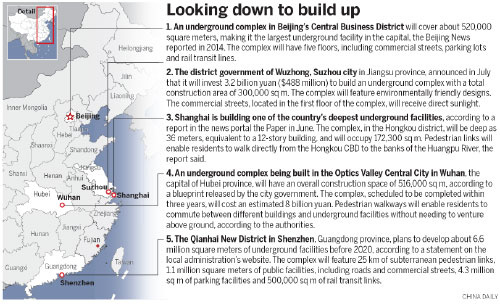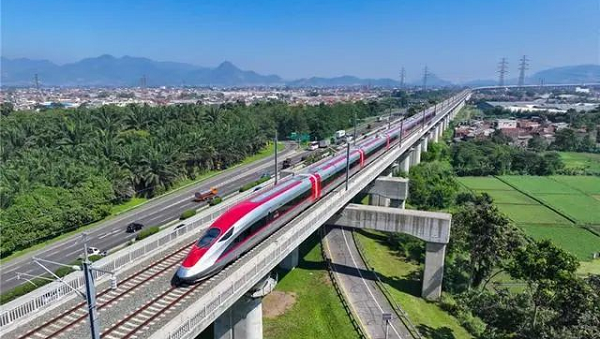Digging deep to explore subterranean space

As land resources become increasingly scarce amid China's urban sprawl, local authorities have resorted to a new frontier for space: the world below our feet. A number of cities have decided to tap this underground space to reduce the mounting pressures on available land in high-density urban areas.
In late December, Wuhan, the capital of Hubei province, announced that construction had started on one of the country's largest "underground cities".
According to a blueprint released by the city government, the underground complex being built in the Optics Valley Central City will cost an estimated 8 billion yuan ($1.22 billion). The three-story project, scheduled to be completed within three years, will have an overall construction space of 516,000 square meters, equivalent to 72 soccer fields.
Qianhai New District, in Shenzhen, Guangdong province, has also unveiled plans to develop about 6.6 million square meters of underground facilities in its urban areas, according to a Dec 2 announcement on the district administration's official website.
"It is an irreversible trend that cities across China are looking for more space underground," said Chen Zhilong, president of the Chinese Society of Underground Space, a non-governmental academic organization that researches the development of underground spaces.
Chen said China's rapid urbanization, coupled with infrastructure problems, including shortages of land, severe traffic congestion and a lack of parking space, has motivated authorities nationwide to accelerate the development of subterranean construction programs: "In crowded urban areas, it will create space for shopping malls, public spaces, underground roads and pedestrian walkways."
Rapid development
Underground construction is not a new phenomenon in China's cities. At a forum last year, Qian Qihu, a member of the Chinese Academy of Engineering Sciences and a leading authority on the development of underground space, said that since the start of the century, the country has developed three times the area of underground space than during the preceding 46 years.
More than 2,000 underground facilities were developed between 2011 and last year, and Shanghai and Beijing have each developed more than 50 million sq m of underground facilities so far, he noted.
According to a white paper published by the Chinese Society of Underground Space last year, as of 2014, at least 40 cities had drawn up plans for the development of underground resources.
With more subterranean spaces set to be developed in coming years, experts said the major challenges will be related to a lack of legislation on the use of underground resources and the absence of official supervision.
At present, the only legislation on the development and use of underground space is a regulation issued by the Ministry of Housing and Urban-Rural Development in 1997.
Yang Xu, vice-president of the China City Development Academy, who has conducted research into the development of underground space, said the regulation lacks bite compared with specially formulated laws.
"The lack of a specific law means it's difficult for the authorities to formulate a national-level plan on the development of underground space. A law would also clearly identify the responsibilities of the government department that supervises the area," he said.
Also, without specific legislation, the property rights related to a large number of underground facilities remain unclear, he added.

Going underground
Going forward, many first-tier cities have prioritized the development of underground facilities in their urban development programs.
The underground complex in Wuhan has been designed to incorporate commercial walkways lined with stores, cinemas, fitness clubs and other leisure facilities, according to the Optics Valley Central City administrative committee.
The deepest facilities in the complex, including the rail transit system, parking lots and pipeline corridors, will be built 27 meters below the streets.
Jian Jianyong, deputy head of the project's management committee, told the online news portal People that the growth of underground facilities will be an important part of the development of central urban districts in the years to come.
"The fact that the facilities are located underground will protect them from the changing weather and effect of the above-ground environment. Thus, they will provide urbanites with cozy, modern and consistent user experiences, even during cold, rainy or snowy conditions," he said.
A report published by the Shanghai Municipal Department of Urban Planning and Land and Resources said that by 2011, the city was home to more than 31,000 underground facilities, including railways and roads, retailers and cultural and sporting facilities covering an area of almost 57 million sq m.
Research conducted in 2014 by Tsinghua University's institute of underground engineering showed that in Beijing, real estate and urban transit development have resulted in the construction of more than 3 million sq m of underground facilities every year in the past decade.
Yang Xu, vice-president of the China City Development Academy and a political adviser to the Chinese People's Political Consultative Conference, the nation's top consultative body, said Beijing should expand the development of underground space in tandem with construction of a new airport in Daxing district.
"The development of such facilities should be in line with the growth of the urban transit system," he said.
Many cities, including Guangzhou and Shenzhen, still have huge potential for more-efficient land use, according to a report, called "Urban China: Toward Efficient, Inclusive and Sustainable Urbanization", jointly published by the World Bank and the State Council's Development Research Center in March 2014.
"If Guangzhou had the same density as Seoul, it could accommodate 4.2 million additional inhabitants on the existing land, while Shenzhen could accommodate an additional 5.3 million inhabitants," the report said.
Shaun Brodie, head of China Strategy Research at DTZ Cushman & Wakefield, a multinational provider of property services, said he expects underground retail project investors and owners in Shanghai to have an even greater interest in improving the design and layout of future projects because the cost of above-ground development continues to escalate in line with the growing pressure on land available in the center of the city.
He said underground properties have a number of advantages. For example, geothermal energy was used to provide 30 percent of the air-conditioning at the Shanghai World Expo in 2010.
Brodie, who is based in Shanghai, said the opening of new urban metro transit lines will result in much more foot traffic being attracted to underground commercial facilities, given the convenient point-to-point access and the stable environment.
Zhu Wenjun, a researcher with Tsinghua University's institute of underground engineering, said subterranean projects can be two to three times more expensive than surface-based projects because the construction costs are higher. "The cost can only be balanced when the economy, density of urban development and real estate price reach certain levels," he said.
Zhu said underground commercial facilities would be a main source of revenue for developers, and the money they generate could effectively cover the costs of other facilities, including pedestrian links and parking lots which usually make little profit.
Based on the experience of similar construction projects in Japan, it takes about 10 years for real estate developers to recoup their investment and begin making a profit, he said.
Hidden worries
However, with the rising development of facilities, many experts have warned that extensive soil investigations are needed before work begins on the construction of underground facilities.
Zhu said research into the environmental impact of such developments, especially on groundwater levels, is still in its infancy, because the effects can only be clearly evaluated after a number of decades have passed.
Moreover, many underground projects were hastily approved because officials in some cities were eager to push forward projects during their tenures. "The research and investigation periods for some projects were far from adequate. That's very shortsighted," he said.
Chen, of the underground space society, said fire prevention is another pressing problem that could hinder the development of projects. "In the case of fire, it would be very difficult for firefighters and their equipment to reach premises underground," he said.
Another potential problem is the disposal of a large amount of construction waste, especially subsoil, generated by the development process.
On Dec 20, the collapse of a mountain of construction waste in the Guangming New Area of Shenzhen killed at least 73 people, and four were still unaccounted for on Jan 28, the last time the figure was updated.
Five days after the collapse, a State Council investigation team determined that the catastrophe was a work safety incident, not a geological phenomenon. An investigation is ongoing.
Shenzhen's exploration of underground space, including rail transit lines and underground infrastructure, as well as construction of the underground infrastructure, has produced such a large amount of subsoil that local dumping sites have been unable to process it, according to Chen Jialong, a professor at the Beijing University of Civil Engineering and Architecture who monitors the disposal of subsoil and construction waste.
Zhu said underground spaces should be regarded as a type of natural resource, and they are irrecoverable once they have been developed and utilized. "It would be very difficult to put things back to how they were once you have taken everything out of the ground," he said.
"Before green lighting any projects, the authorities should ask themselves this question: is it absolute necessary to move the facilities underground? If not, then they should conserve their resources for the future," he said.




